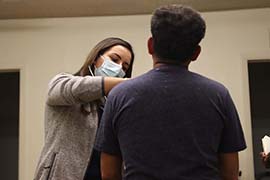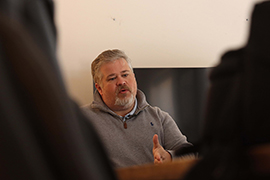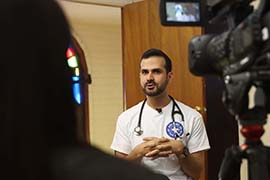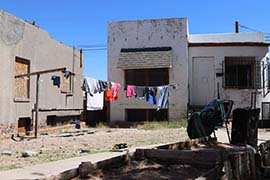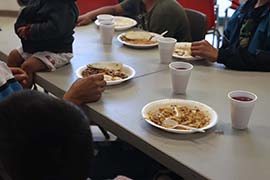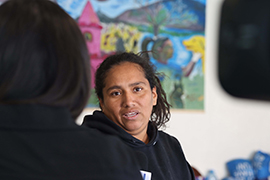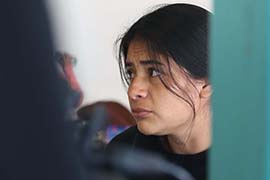- Slug: BC-CNS-Migrant Health,1800 words.
- 11 photos, video story available (thumbnails, captions below).
By Ariana Araiza
Cronkite News
EL PASO, Texas – The migrants seeking a new land have traveled for weeks and many miles, some with toddlers and babies, most with an aura of hope and faith that the journey will be worth it. The ills and medical conditions many arrive with span the mundane to the horrific.
A young child with bone cancer. Someone suffering from a hard fall from the border wall. Others with sniffles from a cold. People weighted with anxiety and depression from being robbed or assaulted as they made their way to the border.
They come to an El Paso clinic like Centro de los Trabajadores Agrícolas Fronterizo, a squat, soil-brown building surrounded by single-family homes and tucked alongside a Catholic church. Here, volunteer doctors and other health-care professionals provide care for migrants who need medical attention.
One migrant sits on the exam table. The doctor speaks with him in Spanish, translating the conversation to a medical student who takes notes.
“He said his construction job back home left him with an eye infection. But he’s mainly concerned that his left hand hurts,” the doctor says.
One more patient in an overflow of need.
A humanitarian blend of medical, shelter and government workers reach out, day after day, to try to help some of the thousands who cross into this Texas city, across the border from its municipal twin, Ciudad Juárez in Chihuahua, Mexico. El Paso city officials estimate that an average 250 people daily – up to 1,000 daily during surges – make their way from half a dozen countries, mainly from South America. It’s a familiar scenario repeated in other border states that officials feared would rise even further after U.S. regulations to slow the tide expired this month. Those who advocate for such help applaud the efforts but say it is not enough – in particular, there aren’t enough psychologists or therapists to deal with the emotional and psychological damage of migrants’ journey. Even the help that is offered is under siege, as conservatives and others conflicted about immigration seek to make it more difficult to offer help.
Dylan Corbett, founding executive director of Hope Border Institute, which operates a clinic in a shelter in Mexico, said migrants often encounter trauma.
“Some people are going to go through a number of obstacles, they’ll be harassed by the police, they might be vulnerable to gangs, and a lot of women are subjected to abuse,” Corbett said.
A tide of people asking for help
The flow of migrants needing medical care in the border states of California, Arizona, New Mexico and Texas is like a spigot that doesn’t shut off. Current numbers are difficult to come by but the National Library of Medicine, in a 2022 study, estimated that from October 2018 to February 2020, volunteers provided care from 15,736 and 19,236 times, at a cost between $1.9 million and $4.4 million.
Migrant services have become so central to El Paso, a Hispanic-majority city of nearly 680,000, that the city government devotes a website page to the “Migrant Crisis.” It offers a dashboard of data, suggestions on how to donate and FAQs on a situation where people “come from all parts of the world to escape economic devastation and extreme crime.”
Soroush Omidvarnia, a second-year medical student at Texas Tech University Health Sciences Center El Paso, migrated to the U.S. from Iran in 2017 because, as a gay man, he feared violence.
Omidvarnia said he chose the university’s medical school specifically because he could help migrants. He relates to their need for resources and access to care.
“That human-to-human interaction is a great part of this clinic,” Omidvarnia said. “Just hearing about all of these struggles that they go through is really personal.”
Migrants spend a few days to a few weeks visiting the El Paso clinic for serious problems, like diabetes or physical injuries, until they are ready to move on to other parts of the country.
“It’s really important for us to not just provide care for the condition that just brings them to us, but also find out what other needs they have,” Omidvarnia said.
Dr. Glenn Fennelly, who chairs pediatrics at the health sciences center, said migrants are simply trying to seek a better way of life and need help along the way.
“There are people that face a literal and figurative barrier of getting from where they’re trying to escape from, to a place where they see better opportunity and better safety,” Fennelly said.
“Many have very pressing health-care needs – in certain instances, addressing the trauma of literally falling off the wall,” he said.
The common route migrants take from South America runs through the Darien Gap, the crossing between Colombia and Panama. It’s a route of diverse and often vicious topography – mountains, jungle, rivers and swamps, where carnivorous animals roam.
Some predators are humans.
Migrants are subject to violence, rape and robbery.
“For each of the different experiences, they’re going to be exposed to different types of trauma along the way,” Corbett said.
Illness and injury are common.
Migrants become more susceptible to severe infections and diseases, while others travel thousands of miles without daily medications.
“Many have walked in shoes that don’t have proper soles. They have cactus needles in their feet,” Fennelly said. “Worst-case scenario, individuals choose to try to climb over the wall and they fall off and that ends badly. There is nothing to absorb that impact other than the hard ground.”
The health crisis was growing as early as 2019, according to a Harvard Global Health Institute study that year, with undiagnosed or untreated diseases and frayed mental health the norm.
”By the time asylum seekers arrive at the border, many have already faced traumatic experiences in their home country and during their journeys.” the study said. “The living environment makes migrants vulnerable to new infections and violence and exacerbates existing health conditions. Inaccessible housing forces asylum seekers into overcrowded shelters, rented rooms, or tent encampments, which often lack sufficient access to basic sanitation, putting asylum seekers at risk for infectious diseases.”
Shelter after a grueling journey
Another El Paso shelter that was once home to U.S. citizens who experienced homelessness opened its doors in August to migrants.
The Centro de los Trabajadores Agrícolas Fronterizos sits just a few blocks from the border wall, facing Ciudad Juárez.
The signs of a 60-mile trail through jungle and mountains scatter around the white walls of shelter. Blankets serve as makeshift beds on the floor, with dirt-marked backpacks and shoes tucked nearby.
One family huddled in a corner, laughing and smiling as a newborn baby sleeps. A daughter rubs her father’s feet.
Diana Ureña, a migrant from Ecuador, said her family’s journey to the U.S. started when gangs demanded money that their family didn’t have. Fear of being murdered sent the family through the Darien Gap.
Ureña, her husband and six children fled shortly after she gave birth to a son, now 1 month old. They brought only belongings they could stuff into a few backpacks and duffel bags. She sat on a bench, speaking in Spanish about her journey.
“Can you imagine living through that, in the jungle one sees dead people, one sees everything,” Ureña said. “There are girls they rape, so one comes with that fear the whole journey. I have my 13-year-old daughter, imagine that, it’s horrible.”
The trip took two months and they were robbed twice, leaving them with little money.
“A lot happened because everything happens to you on the way, arriving in Juárez I couldn’t take it anymore, I had a lot of anxiety,” Ureña said. “Then in Ciudad Juárez, I was anxious, I wanted to scream, I didn’t even know what I had.”
Another migrant, Solangi Uscategi, traveled with her husband and her two children from Colombia.
“There were agents who were abusive, they touched you, they groped you to see if you had money,” Uscategi said in Spanish. “The way you felt, it felt horrible, obviously. It didn’t feel well.”
Help provided on both sides of the U.S.-Mexico border
Texas Tech’s volunteer doctors and those who run shelters like the one in El Paso and the Hope Institute in Ciudad Juárez, work to treat migrants on both sides of the border. Some leaders feel a moral obligation to step in to supplement a system where the government either can’t, or won’t, step in.
Some organizations are just getting started.
Hope Border Institute opened its clinic in September, inside one of the largest Mexican shelters in Ciudad Juarez.
The clinic is largely staffed by El Paso doctors and psychologists who volunteer their time to drive into the border city on Saturday mornings.
One day in April, Corbett teared up when asked why he does this work, thinking of the trauma he’s witnessed.
“The burden falls on civil society and community organizations to stand up because this is a population that’s largely been forgotten by our governments,” Corbett said.
Fennelly said one small solution is a three-way collaboration with Texas Tech El Paso, Doctors of the World, and Annunciation House that created the Border Health Program. Volunteer doctors and students offer free exams and other medical attention at the El Paso clinic, which opened in January.
Although experts applaud the efforts, they say it is not enough – in particular, there aren’t enough psychologists or therapists to treat migrants’ emotional and psychological damage.
“The amount of people requiring mental-health services has gone up,” Corbett said. “People just need psychological assistance, they need therapy.”
Determination rises with political controversy
The political waters swirling around care for migrants, medical and otherwise, continued even as Title 42 expired in early May. The U.S. border-policy restricted immigration and a tide of migrants was expected to swell El Paso once again.
More migrants, more help needed.
El Paso city officials on May 8 declared a state of emergency. The declaration lists 34 “whereas” of disaster headed its way, as if a 100-year flood is bearing down on the city. It notes, again and again, of the desperation for shelter:
“Whereas, there are significant public safety and security concerns related to the wave of migration, including but not limited to the risk of injury or loss of life with migrants in El Paso streets with little or no resources on days that reach extremely high or freezing low temperatures and the inherent risks that come with increased demand on local shelters.”
It’s unknown what happens next for the city.
But amid the uncertainty, certain things continue for migrants. Donors are still being sought, volunteers trained, shelters opened.
The Hope Border Institute, where Corbett works, launched a new shelter, according to a May 12 statement.
“We are ready,” the statement says. “While these will be days of challenge … we’re continuing to provide essential humanitarian aid to those in need.”
For more stories from Cronkite News, visit cronkitenews.azpbs.org.
^__=
A migrant waits in the intake room before being taken into an exam room at a clinic in El Paso. Advocates say hope and faith is a common denominator among migrants who leave home and make their way through hardships on their journey to the U.S. (Photo by Paula Soria/Cronkite News)
A doctor examines a migrant, a construction worker who has an eye infection and an injured left hand. (Photo by Paula Soria/Cronkite News)
The doctor takes a closer look at a patient’s left hand. He says it hurts. (Photo by Paula Soria/Cronkite News)
Migrant services have become so central to El Paso, a Hispanic-majority city of nearly 680,000, that the city government devotes a page on its website to the “Migrant Crisis.” (Photo by Paula Soria/Cronkite News)
Dylan Corbett, founding executive director of Hope Border Institute, which operates a clinic in a shelter in Mexico, said migrants often encounter trauma. (Photo by Paula Soria/Cronkite News)
Soroush Omidvarnia, a second-year medical student at Texas Tech University Health Sciences Center El Paso, is an immigrant from Iran who said he relates to migrants’ need for resources and care. (Photo by Paula Soria/Cronkite News)
Dr. Glenn Fennelly, who chairs pediatrics at Texas Tech University Health Sciences Center El Paso, said many migrants “have very pressing health-care needs – in certain instances, addressing the trauma of literally falling off the wall.” (Photo by Paula Soria/Cronkite News)
Centro de los Trabajadores Agrícolas Fronterizo, an El Paso shelter that was once home to U.S. citizens experiencing homelessness, opened its doors in August to migrants. (Photo by Paula Soria/Cronkite News)
Migrants are fed and children are given coloring books at a newly opened shelter in El Paso. (Photo by Paula Soria/Cronkite News)
Diana Ureña, a migrant from Ecuador, said her family’s journey to the U.S. started when gangs demanded money. But the family didn’t have any. Fear of being murdered sent the family through the Darien Gap. (Photo by Paula Soria/Cronkite News)
Solangi Uscategi traveled with her husband and her two children from Colombia. “There were agents who were abusive, they touched you, they groped you to see if you had money,” Uscategi said in Spanish. (Photo by Paula Soria/Cronkite News)

